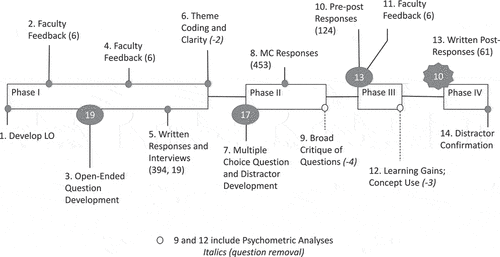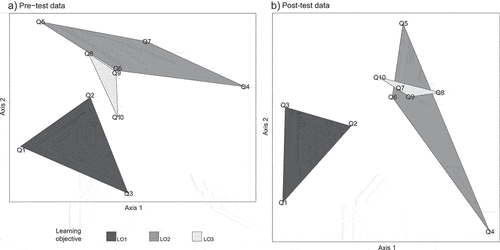Figures & data
Table 1. Developing Mutation Learning Objectives based on GSA guidelines
Table 2. Description of validity and reliability statistical measures.
Table 3. Psychometric Data Table.
Figure 1. Development and testing of the Mutations Criterion Referenced Assessment (MuCRA). The MuCRA was developed in four steps. First (1), the research team developed learning objectives based on their experience, the Genetics Society of America’s curricular guidelines, and feedback from teaching faculty (2). The team then developed open ended questionsto probe student understanding of learning objectives and elicited feedback (3-4) before gathering student data (5). These data were analyzed to identify and encode common errors (6) that were used to develop multiple choice questions (7). We gathered initial and analyzed initial student response data (7-8) and removed 4 questions (9). In phase III, we gathered student and faculty data (10-11) from multiple classrooms and removed 3 questions (12).We confirmed distractors were capturing student thinking by gathering and analyzing student data (13) in phase IV.

Table 4. Congruence Probabilities.
Figure 2. nMDS plots. Non metric multidimensional scaling plots depicting grouping of MuCRA questions (Q1-Q10) by learning objectives for pre-instruction test data (A) and post-instruction test data (B). Learning objective 1 remains distinct from learning objectives 2 and 3 when the MuCRA is used before and after instruction.

Figure 3 Congruence of student rationale with misconception code. For each question in the MuCRA, the proportion of incorrect answers (bottom half) or correct answers (top half) for which student self reported rationale was incongruent(dark) or congruent (light) with the targeted misconception for incorrect responses or correct reasoning for correct responses.

